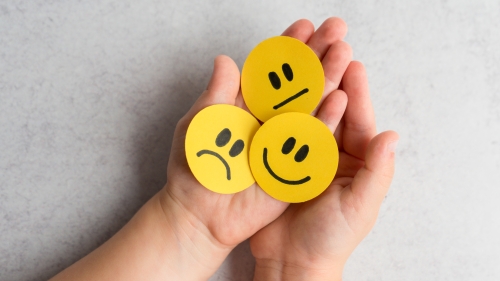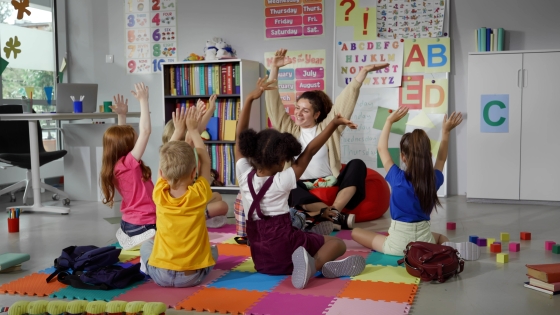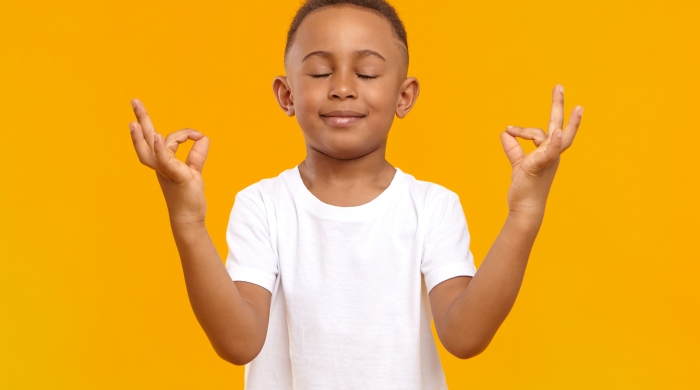
Students learn best when they are emotionally regulated, and educators can support their regulation and success by utilizing co-regulation strategies in the classroom. These are strategies in which educators, parents, or other adults engage in a calming exchange with a child to help soothe and manage their emotions. Co-regulation emphasizes the role of trusted adults in providing consistent guidance, feedback, and encouragement. When adults provide a warm and responsive environment, students can develop emotional awareness, resilience, and life skills through co-regulation.
In this blog post, we share three core strategies—feeling thermometers, calm corners, and breathing strategies—that are typically used in schools to support both students’ ability to self-regulate and educators’ ability to co-regulate with their students.
Feelings Thermometers: Building Emotion Awareness
Feelings thermometers are used by multiple programs, schools, and districts, including the Path program, to help students identify and express their emotions. With a color-coded or numerical scale, this tool visually represents emotional valence and intensity—from calmness to high distress (UCLA CARES Center, 2020). Using this tool, educators guide students to identify emotional triggers, understand their feelings, and explore ways to move through their feelings (Psychology Today, 2014). For example, if students are feeling emotional intensity, teachers will model taking a deep breath and then do it with students together (Therapist Aid, n.d.). By co-regulating with students as they use the thermometer, students will learn strategies for identifying and managing their feelings.
In special education classrooms or diverse learning environments, feelings thermometers support co-regulation by allowing school staff to identify their own feelings alongside students. Teachers, counselors, and parents should work alongside students to help them navigate challenges while promoting emotional literacy and self-regulation skills (Good2Know Network, 2021; Wisconsin Office of Children's Mental Health, 2021).
Calm Corners: Safe Spaces for Regulation
Calm corners provide a physical space where students can manage emotional distress (Maich et al., 2019). Calm corners are equipped with sensory materials (e.g., fidget spinners, stress balls), mindfulness activities (e.g., instructional signs for breathing techniques or emotional regulation tips), and reflective tools (e.g., reflective worksheets on children’s emotions). These are important aspects of classroom and environmental design as they provide a designated space for students to use for regulation. Beginning in younger grades, educators can help younger students learn how to identify and manage their emotions in ways that support their ability to re-engage in learning (Action for Healthy Kids, 2022).
For students who have experienced trauma or need more individualized emotional and behavioral support, calm corners represent a non-punitive way to take a break and practice strategies for emotional regulation (Hilarie et al., 2023). By allowing students to utilize this space when they need it, students can feel a stronger sense of safety, autonomy, and belonging in the classroom.
Co-regulation occurs when educators teach students how to use calm corners effectively by providing supportive prompts, modeling mindfulness practices such as leading a breathing exercise, and helping students identify their emotional states. This student-educator partnership supports students using strategies to regain control and re-enter the classroom environment calmly and confidently.
Breathing Exercises: Respiratory Control of Nervous System
Breathing exercises are a simple yet powerful way to reduce stress, improve focus, and foster mindfulness for students and adults alike. Our breathing reflects and influences how we feel—slowing and deepening when we’re calm or speeding up under stress. Techniques like box breathing, which involves inhaling, holding, and exhaling for four seconds each, are easy to teach and help students of all ages quickly regain calm and focus, while more structured practices like SKY Breath Meditation have been shown to improve mood, destress, and enhance social connection in older students (Belli, 2020; Cleveland Clinic, 2021).
For example, after a noisy and high-energy recess, a teacher can model calming behaviors and guide the class through box breathing to help them settle their minds and bodies: “Breathe in… one, two, three, four. Hold… one, two, three, four. Exhale… one, two, three, four. Hold… one, two, three, four.” (Gotter, 2020). In just a few cycles, the room may shift from unsettled to calm, with students ready to focus on the next activity. By incorporating such exercises into routines—whether in community circles to start the day, after transitioning from recess, or during tense moments—breathing techniques can support both teachers’ and students’ sense of peace and ability to focus on learning.
References
Action for Healthy Kids. (2022). Calm down corner. https://www.actionforhealthykids.org/activity/calm-down-corner
André, C. (2024, February 20). Proper breathing brings better health. Scientific American. https://www.scientificamerican.com/article/proper-breathing-brings-better-health
Barrett, P., & Zhang, Y. (2009). Optimal learning spaces: Design implications for primary schools. Salford, UK: Design and Print Group.
Cleveland Clinic. (2021, August 17). How box breathing can help you destress. https://health.clevelandclinic.org/box-breathing-benefits
Gimbert, B. G., Miller, D., Herman, E., Breedlove, M., & Molina, C. E. (2023). Social emotional learning in schools: The importance of educator competence. Journal of Research on Leadership Education, 18(1), 3–39. https://doi.org/10.1177/19427751211014920
Good2Know Network. (2021). Feelings thermometer: Free multilingual resource for educators & families. Retrieved October 10, 2023, from https://good2knownetwork.org
Harmon, W. (2019). How to create a calm down corner in 5 easy steps. The Art of Education University. https://theartofeducation.edu/2019/01/how-to-create-a-calm-down-corner-in-5-easy-steps
Hilaire, B., Campbell, L. O., Lambie, G. W., Stickl Haugen, J., & Frawley, C. (2023). Cultivating supportive school environments during and after shared trauma. The Educational Forum, 88(2), 202–216. https://doi.org/10.1080/00131725.2023.2232418
Lehrer, P. M., & Gevirtz, R. (2014). Heart rate variability biofeedback: How and why does it work? Frontiers in Psychology, 5, 756. https://doi.org/10.3389/fpsyg.2014.00756
Maich, K., Davies, A. W. J., & van Rhijn, T. (2019). A relaxation station in every location. Intervention in School and Clinic, 54(3), 160–165. https://doi.org/10.1177/1053451218767916
Psychology Today. (2014). Why you need to know your emotional temperature. Retrieved October 10, 2023, from https://www.psychologytoday.com
Therapist Aid. (n.d.). Emotion thermometers | Worksheet. Retrieved October 10, 2023, from https://www.therapistaid.com
UCLA CARES Center. (2020). Feeling thermometer. Retrieved October 10, 2023, from https://carescenter.ucla.edu
Wisconsin Office of Children's Mental Health. (2021). OCMH feelings thermometer. Retrieved October 10, 2023, from https://children.wi.gov


